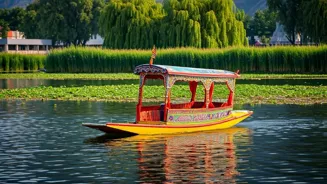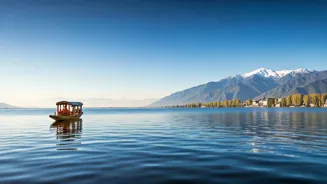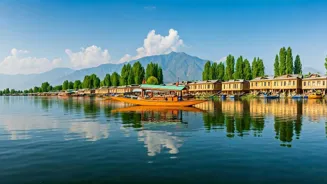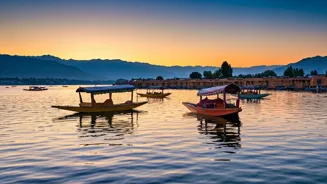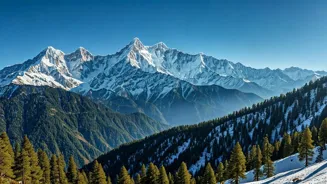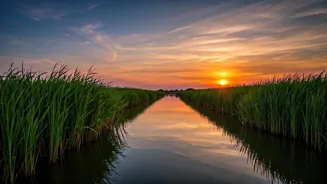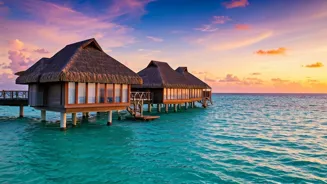Historical Significance
Dal Lake has long been at the core of Srinagar's identity. Its history is intertwined with the rise and fall of empires that held sway over the region.
For centuries, the lake has served as a nexus for trade, transport, and cultural exchange, with various dynasties leaving their mark. The Mughal emperors, known for their love of gardens, recognized Dal Lake's potential, building the Shalimar Bagh and Nishat Bagh gardens, which further enhanced the lake's appeal and established it as a favored retreat. The lake's strategic position made it a hub for connecting different communities and facilitated the growth of settlements along its shores. The lake's historical significance is not only in its strategic importance but also in the way it has shaped the local culture, inspiring art, literature, and a unique way of life centered around its waters.
The Floating Attractions
The most iconic aspects of Dal Lake are the houseboats and shikaras. Houseboats, or 'floating palaces', are a unique type of accommodation, and they offer visitors a distinctive experience on the water. These boats have a rich history dating back to the British colonial era when the rulers were not permitted to own land. Shikaras, small wooden boats, are an intrinsic part of Dal Lake's culture, used for transportation, shopping, and leisure. Local vendors sell goods from their shikaras, creating a floating marketplace. The shikaras also offer scenic tours around the lake, allowing visitors to admire the floating gardens, known as 'Raed,' and the surrounding landscape. This includes the Mughal gardens and the various temples and mosques dotting the shorelines. These attractions are not merely amenities, but they are also a way of life, deeply rooted in the lake's socio-economic fabric.
Daily Life on Dal
Life on Dal Lake is vibrant and unique. The lake sustains a community of people who have adapted their lifestyles to live on its waters. Many families reside in houseboats, and their daily routines are dictated by the rhythm of the lake. Early mornings see the activity of fishermen casting their nets, and the movement of shikaras carrying locals to work or children to school. The floating gardens, locally known as 'Raed,' are where the lake's ecosystem comes alive, with farmers cultivating vegetables and flowers on the fertile beds. The lake also has a thriving marketplace where vendors sell a range of products, from handicrafts to food. Moreover, the lake is an essential source of income for the locals. This provides work opportunities for boatmen, houseboat owners, and vendors, who sustain the local economy. The daily life on the lake has a unique cultural identity, showcasing a blend of tradition and a deep connection with nature.
Environmental Challenges
Despite its charm, Dal Lake has faced numerous environmental challenges that threaten its beauty and the livelihood of its residents. Pollution, primarily from sewage, industrial waste, and domestic runoff, has degraded the water quality. This pollution has triggered eutrophication, the excessive enrichment of nutrients in the water. This leads to the rapid growth of algae and aquatic plants, which decrease oxygen levels and harm aquatic life. The lake has also become prone to sedimentation, where soil particles and other materials are carried into the lake. This reduces its depth and impairs its ability to sustain its ecosystem. Climate change, with erratic weather patterns and rising temperatures, adds further stress to the lake. Efforts to conserve and restore Dal Lake include pollution control measures, dredging to remove sediments, and initiatives to promote sustainable practices among the local community. Preserving Dal Lake requires a sustained, combined approach to preserve its long-term health.
Sustainable Conservation Efforts
Various conservation efforts are in progress to address the environmental challenges facing Dal Lake and to preserve its legacy. The government and local organizations have initiated projects to manage pollution, focusing on upgrading sewage treatment facilities and encouraging eco-friendly practices. Regular dredging is carried out to remove accumulated sediments, which helps to deepen the lake and improve water flow. Awareness campaigns are also conducted to educate residents and tourists about the importance of keeping the lake clean. Moreover, initiatives to promote sustainable tourism are underway, including guidelines for houseboat owners and boat operators. These measures aim to balance tourism with environmental preservation. The goal is to protect the lake's natural resources and encourage a more responsible approach to Dal Lake's conservation for future generations.
